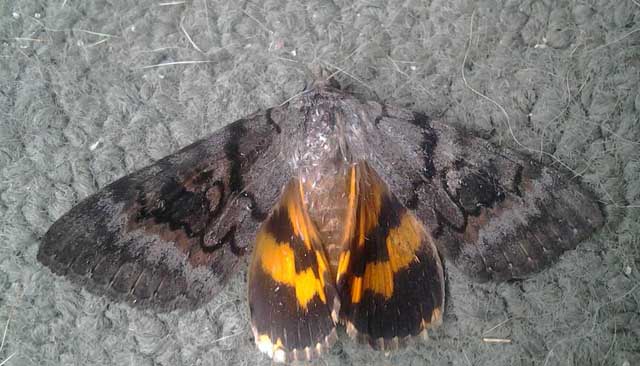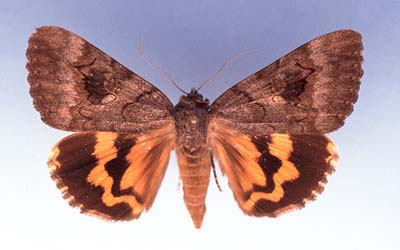Catocala consors
|
|
Updated as per personal communication from Rick Gillmore, (Florida, Hickory), May 7, 2007
Updated as per personal communication with Dan Sundberg, (San Antonio, Texas), May 8, 2012
|
Catocala consors
kah-TOCK-uh-lahMKON-sors
(J.E. Smith, 1797) Phalaena consors

The Consort Underwing, by Dale Clark.

Catocala consors, Devil's River, Val Verde County, Texas,
courtesy of Dave Barker, id confirmed by Larry Gall.

Catocala consors, Devil's River, Val Verde County, Texas,
courtesy of Dave Barker, id by Larry Gall.
The sightings in Val Verde, Texas, represent the most western location in consors' range in the United States as of May 10, 2018.
This site has been created by
Bill Oehlke.
Comments, suggestions and/or additional information are welcomed by Bill.
| TAXONOMY:
Superfamily: Noctuoidea
Family: Erebidae, Leach, [1815]
Subfamily: Erebinae, Leach, [1815]
Tribe: Catocalini, Boisduval, [1828]
Genus: Catocala, Schrank, 1802
|
DISTRIBUTION:
Catocala consors consors and subspecies C. consors scorsoni
(now, 2010, a synonym of nominate consors)
(wingspan: 70mm plus) fly from Maine and
Connecticut (unconfirmed) south to
Florida and west to Texas and eastern
Oklahoma.
It has also been reported in Georgia,
Arkansas,
Illinois,
Indiana,
Iowa,
Kansas,
Kentucky,
Louisiana,
Mississippi,
Missouri,
New Jersey,
New York,
North Carolina,
Ohio,
Pennsylvania,
South Carolina,
Tennessee and
Virginia.

Catocala consors, San Antonio, Texas, May 8, 2012, courtesy of Dan Sundberg.
As far as is known, habitats are open, xeric, scrubby oak-hickory or oak-pine-hickory woodland or sprout growth. A.E. Brower found it in logged areas in Missouri.
Schweitzer suggests large scale tornado blow downs or places recovering from wildfires would be good places to look. Frequent prescribed burning could be a negative habitat
indicator. Probably also occurs on ridges etc. where edaphic conditions keep tree growth sparse. the only certain key habitat feature is small section EUCARYA hickories, but
there are obviously others.
Food Habits The larva eats spring new growth foliage of small hickories probably only section EUCARYA. Probably larvae occur mostly on saplings or sprouts less than two
meters tall. This species does not require shagbark hickory like several congeneric species do. By habitat association either or both of CARYA PALLIDA and C. TOMENTOSA are
foodplants in New Jersey.
Phenology in New Jersey and Illinois: adults occur in July from larvae hatching about the beginning of May and maturing in about a month. The pupal stage is also about a
month. Adults probably appear at the end of May at extreme southern end of range. In general they can be expected with the closely related, ecologically similar and
common C. epione in any given area. Local collectors will know when C. epione occurs. Adults fly at night but can be flushed from leaf litter under
shrubs by day and may move around to seek shade. Larvae feed mostly at night but (C. C. consors at least) usually do not leave the small hickories by day.
Rick Gillmore writes, "It is very common in Seminole, Orange and
Citrus counties in central Florida. The larvae is found on hickory
trees, not Amorpha fructicosa. In fact, I seriously doubt that
C. consors larvae feed on Amorpha fructicosa."
The forewing has irregular am and
pm narrow black lines. The orange-yellow pm band tends to be narrow and irregularly
zigzagged. Sometimes the band is wider and slightly less irregular.
Catocala consors is the same as C. pensacola Reiff, 1919.
There is a subspecies sorsconi Barnes and Benjamin, 1924.
FLIGHT TIMES AND PREFERRED FOOD PLANTS:
In northern
portions of its range, Catocala consors flies as a single
generation with moths on the wing gernerally starting in May.
In more southerly locales there may be multiple
flights with moths
on the wing from late April into July, but it is generally felt that
there is a single brood annually. There is a Texas record for April 26.
Catocala consors courtesy of James K. Adams, Georgia.
|  |
The Catocala consors caterpillar shows a preference for
Amorpha fructicosa (Bastard indigo) questionable.
Carya (hickory) is a primary host (RG).
ECLOSION:
Adults eclose from flimsy cocoons amongst leaf litter, or possibly even from flimsy cocoons still affixed to live tree leaves.
SCENTING AND MATING:
Catocala consors females
emit an airbourne pheromone and males use their antennae to track the
scent plume.
EGGS, CATERPILLARS, COCOONS AND PUPAE:
Eggs are deposited on tree bark in the fall and hatch the following spring.
Mature larvae Image courtesy of |
 |
Larval Food Plants
Listed below are primary food plant(s) and alternate food plants.
It is hoped that this alphabetical listing followed by the common
name of the foodplant will prove useful. The list is not exhaustive,
although some species seem very host specific.
Experimenting with closely related foodplants is worthwhile.
Amorpha fructicosa .......
Carya
|
Bastard indigo questionable
Hickory
|
Return to Main Index
This page is brought to you by Bill Oehlke and the
WLSS. Pages are on space rented from Bizland. If you would like to become a "Patron of the Sphingidae/Catocala Sites", contact Bill.
Please send sightings/images to Bill. I will do my best to respond to requests for identification help.
Enjoy one of nature's wonderments: Live Saturniidae (Giant Silkmoth) cocoons.

|

To show appreciation for this site, click on the flashing
butterfly to the left, a link
to many worldwide insect sites. |






